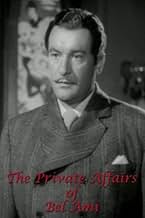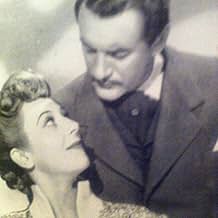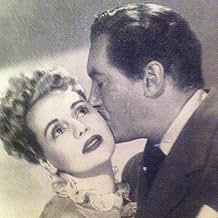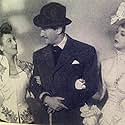AVALIAÇÃO DA IMDb
6,7/10
872
SUA AVALIAÇÃO
Adicionar um enredo no seu idiomaIn 1880, in Paris, chance brought together two former comrades-in-arms - Charles Forestier, who had become a journalist for "La Vie française" - and Georges Duroy, idle since leaving the six... Ler tudoIn 1880, in Paris, chance brought together two former comrades-in-arms - Charles Forestier, who had become a journalist for "La Vie française" - and Georges Duroy, idle since leaving the sixth regiment of hussars.In 1880, in Paris, chance brought together two former comrades-in-arms - Charles Forestier, who had become a journalist for "La Vie française" - and Georges Duroy, idle since leaving the sixth regiment of hussars.
- Direção
- Roteiristas
- Artistas
Susan Douglas Rubes
- Suzanne Walter
- (as Susan Douglas)
- Direção
- Roteiristas
- Elenco e equipe completos
- Produção, bilheteria e muito mais no IMDbPro
Avaliações em destaque
Albert Lewin's reputation rests almost entirely on two films, "The Picture of Dorian Gray" and "Pandora and the Flying Dutchman" but his masterpiece must surely be the little known and little seen "The Private Affairs of Bel Ami" from the novel by Guy De Maupassant. It is, of course, a very witty portrait of a cad, beautifully played by George Sanders, but it is also a film of considerable psychological depth and one of the most adult and intelligent American pictures of the forties with not a trace of the camp usually associated with the director.
Rather we get an incisive picture of a period and that rarefied milieu of high Parisian society, beautifully written by Lewin and superbly played by everyone. In particular Angela Lansbury is outstanding as the one woman Sanders might actually have feelings for. It's a great performance that should have made Lansbury a major Hollywood player rather than simply the great character actress she became. Even the usually wooden Warren William excels here. If any film cries out for a restoration it is this one.
Rather we get an incisive picture of a period and that rarefied milieu of high Parisian society, beautifully written by Lewin and superbly played by everyone. In particular Angela Lansbury is outstanding as the one woman Sanders might actually have feelings for. It's a great performance that should have made Lansbury a major Hollywood player rather than simply the great character actress she became. Even the usually wooden Warren William excels here. If any film cries out for a restoration it is this one.
The Private Affairs of Bel Ami gave George Sanders to play a leading role as Guy de Maupassant's gentleman cad who rises in Parisian society over the bodies of a number of seduced and abandoned women. Sanders is a former dragoon who uses his charm to acquire money and power and in the end a title of minor nobility in Third Republic France. The one woman whom he truly loves, Angela Lansbury, is forever lost to him. Would she have brought him real happiness? It's for the audience to judge.
The comparisons between Bel Ami and Sanders's Oscar winning Addison DeWitt have to be made. Both men are cynics about human nature, but whereas theater critic DeWitt is an observer and a behind the scenes manipulator of others, Bel Ami is doing it all for his own advancement. Both performances have that touch of cad about them and they rank as some of the best work George Sanders did.
Look for good performances from John Carradine as Sanders's only true male friend and Angela Lansbury who he loves, but who can't give him the social standing he needs.
Also of course look for Warren William in his farewell role as Sanders's main antagonist. A not very brave, but a fairly shrewd sort, Sanders regularly bests him until the very end.
The Private Affairs of Bel Ami was a rather daring film for Code run Hollywood, it doesn't surprise me it was an independent movie, released by United Artists.
Fans of The Eternal Cad George Sanders will eat it up.
The comparisons between Bel Ami and Sanders's Oscar winning Addison DeWitt have to be made. Both men are cynics about human nature, but whereas theater critic DeWitt is an observer and a behind the scenes manipulator of others, Bel Ami is doing it all for his own advancement. Both performances have that touch of cad about them and they rank as some of the best work George Sanders did.
Look for good performances from John Carradine as Sanders's only true male friend and Angela Lansbury who he loves, but who can't give him the social standing he needs.
Also of course look for Warren William in his farewell role as Sanders's main antagonist. A not very brave, but a fairly shrewd sort, Sanders regularly bests him until the very end.
The Private Affairs of Bel Ami was a rather daring film for Code run Hollywood, it doesn't surprise me it was an independent movie, released by United Artists.
Fans of The Eternal Cad George Sanders will eat it up.
The Private Affairs of Bel Ami (1947)
The weary diffidence of George Sanders makes this movie what it is, but there is a rather large cast of important characters who hold up their types, too. Only Sanders in the lead role (as the Bel Ami) has full roundness to his character. Look, however, for John Carradine and Elsa Lancaster, both welcome and convincing, though they only appear sporadically. Ann Dvorak takes on the second most important role and she's terrific, cast perfectly and acting with cunning.
The story is a period piece, set in late 19th century France. It centers really around one idea--Sanders, who is portraying a real lady's man, gets several women interested in him (or he in them) with somewhat suspicious goals (like money) under his hat. The first half of the movie has these women at odds with each other and Sanders playing his hand just so. Then he lands one of them and a different kind of ambition takes over his life, with some tricks to become yet wealthier. And the movie shifts. It gets fairly complex, based on a French novel by Guy de Maupassant. It has enormous potential, and yet it never quite gels. You can imagine a "Magnificent Ambersons" kind of construction to make it work, but that would require more length. And Orson Welles.
The writing is naturally amazing at times. The characters, as much as they get developed, are intelligent and say intelligent things.
There are two aspects that plague this version. First is Sanders himself. He's one of my favorite actors of this era, but he has a limited kind of style and he's miscast here, lacking the charm and fast wit you would need to pull off all these machinations, some romantic and some political. Second is the way the story is told, cramming the pieces together, jumping from one moment into the future as if there wasn't time to mention that so and so meanwhile died, or that our main man in fact got married. Sometimes this kind of economy makes for a fast movie, but here it feels too harshly edited.
And then there is the slight falseness to the filming, all done in studios, with hints of the city in the background, beautiful but unconvincing light, and sound that is dubbed or added and is sometimes painfully wrong (Sanders whistling without moving his lips, Carradine playing a complicated accordion piece on an instrument without keys, footsteps on a stone walk that sound like a wooden stage, a singer who...you get the idea). The director, Albert Lewin, had a thriving career writing for silent movies (there is an irony in that, I suppose), then he became a producer in the 1930s before switching to directing just a half dozen films in the 1940s. Only one of these has a reputation--The Picture of Dorian Gray--with this one a kind of runner-up. But whatever its promise, it struggles to take off as either a romantic heart-tugger or a social high drama.
Small tidbit--Uma Thurman and others are filming a remake of this story, and naturally all the womanizing has taken on a sexual quality, from what I can see. That's a strength with the way Lewin shot and edited this early one, because we get the way the leading man is a selfish cad without having to get distracted into the prurient details that would distract, even further, from the larger plot.
The weary diffidence of George Sanders makes this movie what it is, but there is a rather large cast of important characters who hold up their types, too. Only Sanders in the lead role (as the Bel Ami) has full roundness to his character. Look, however, for John Carradine and Elsa Lancaster, both welcome and convincing, though they only appear sporadically. Ann Dvorak takes on the second most important role and she's terrific, cast perfectly and acting with cunning.
The story is a period piece, set in late 19th century France. It centers really around one idea--Sanders, who is portraying a real lady's man, gets several women interested in him (or he in them) with somewhat suspicious goals (like money) under his hat. The first half of the movie has these women at odds with each other and Sanders playing his hand just so. Then he lands one of them and a different kind of ambition takes over his life, with some tricks to become yet wealthier. And the movie shifts. It gets fairly complex, based on a French novel by Guy de Maupassant. It has enormous potential, and yet it never quite gels. You can imagine a "Magnificent Ambersons" kind of construction to make it work, but that would require more length. And Orson Welles.
The writing is naturally amazing at times. The characters, as much as they get developed, are intelligent and say intelligent things.
There are two aspects that plague this version. First is Sanders himself. He's one of my favorite actors of this era, but he has a limited kind of style and he's miscast here, lacking the charm and fast wit you would need to pull off all these machinations, some romantic and some political. Second is the way the story is told, cramming the pieces together, jumping from one moment into the future as if there wasn't time to mention that so and so meanwhile died, or that our main man in fact got married. Sometimes this kind of economy makes for a fast movie, but here it feels too harshly edited.
And then there is the slight falseness to the filming, all done in studios, with hints of the city in the background, beautiful but unconvincing light, and sound that is dubbed or added and is sometimes painfully wrong (Sanders whistling without moving his lips, Carradine playing a complicated accordion piece on an instrument without keys, footsteps on a stone walk that sound like a wooden stage, a singer who...you get the idea). The director, Albert Lewin, had a thriving career writing for silent movies (there is an irony in that, I suppose), then he became a producer in the 1930s before switching to directing just a half dozen films in the 1940s. Only one of these has a reputation--The Picture of Dorian Gray--with this one a kind of runner-up. But whatever its promise, it struggles to take off as either a romantic heart-tugger or a social high drama.
Small tidbit--Uma Thurman and others are filming a remake of this story, and naturally all the womanizing has taken on a sexual quality, from what I can see. That's a strength with the way Lewin shot and edited this early one, because we get the way the leading man is a selfish cad without having to get distracted into the prurient details that would distract, even further, from the larger plot.
"The Private Affairs of Bel Ami" is one of the most unusual films to come out of Hollywood during the Golden Age of Hollywood (1920-1950). An adaptation of a Guy de Maupassant work, "Bel Ami" honestly and bitingly portrays an "homme fatale", a man who uses sex to gain social, economic, and political power. This is the only film, to my knowledge, that portrays such a phenomenon that in real life has been much more common than is commonly held.
George Sanders was never better than as Georges DuRoy. His playing displays the numbing of feelings, desperation of a life of poverty and low social rank, and misogyny that propel him to do what he does. No film character in the Golden Age of Hollywood was as blatantly hateful of women as Georges DuRoy. Witness the scenes with Sanders and Marie Wilson!
The female characters display a moderness in attitudes, relationships with men, and an awareness of their roles in their relationships with Georges DuRoy that is startling not just for 1880, but for 1947, when the film was released. Only French and some Italian films of the 1960's have equalled that frankness by female characters of what their place is in the lives of men.
Ann Dvorak carries much of the film gracefully and with a strong, frank portrayal of a woman much like Georges DuRoy and unapologetic about it. This is definitely Dvorak's finest and the showiest role of her career. Unfortunately, it did not propel her to major stardom and she retired from acting only three years after filming "The Private Affairs of Bel Ami".
Angela Lansbury proved here in this early film of her career what a fine character actress she is. Her portrayal of Clothilde could've been pathetic. Instead, Clothilde emerges as well-rounded character who is never tiresome to watch.
Marie Wilson never got a dramatic part like the one in this film as a Folies Bergere dancer. She only proves the point that behind every great comedienne lies a fine dramatic actress. She truly evokes a character, not the dumb blonde comedy relief that was her stock-in-trade.
A surprising number of top character actors in this film! The film's look and score are very noirish. That only highlights the modernity of the characters in the film, much like 2000's "Moulin Rouge".
The movie looks and plays like an RKO-Radio film noir of the mid-'40's.
Cool concept. The startling use of color for the one scene in which it is used only adds to the uniqueness of this film's acting and look.
The only drawback is the use of decidedly obvious painted backdrops. They only highlight the low budget that was obviously involved in making the film. Too bad, while the rest of the sets appear well-lighted and -appointed.
An arresting film! Definitely worthy of critical and popular reevaluation!
George Sanders was never better than as Georges DuRoy. His playing displays the numbing of feelings, desperation of a life of poverty and low social rank, and misogyny that propel him to do what he does. No film character in the Golden Age of Hollywood was as blatantly hateful of women as Georges DuRoy. Witness the scenes with Sanders and Marie Wilson!
The female characters display a moderness in attitudes, relationships with men, and an awareness of their roles in their relationships with Georges DuRoy that is startling not just for 1880, but for 1947, when the film was released. Only French and some Italian films of the 1960's have equalled that frankness by female characters of what their place is in the lives of men.
Ann Dvorak carries much of the film gracefully and with a strong, frank portrayal of a woman much like Georges DuRoy and unapologetic about it. This is definitely Dvorak's finest and the showiest role of her career. Unfortunately, it did not propel her to major stardom and she retired from acting only three years after filming "The Private Affairs of Bel Ami".
Angela Lansbury proved here in this early film of her career what a fine character actress she is. Her portrayal of Clothilde could've been pathetic. Instead, Clothilde emerges as well-rounded character who is never tiresome to watch.
Marie Wilson never got a dramatic part like the one in this film as a Folies Bergere dancer. She only proves the point that behind every great comedienne lies a fine dramatic actress. She truly evokes a character, not the dumb blonde comedy relief that was her stock-in-trade.
A surprising number of top character actors in this film! The film's look and score are very noirish. That only highlights the modernity of the characters in the film, much like 2000's "Moulin Rouge".
The movie looks and plays like an RKO-Radio film noir of the mid-'40's.
Cool concept. The startling use of color for the one scene in which it is used only adds to the uniqueness of this film's acting and look.
The only drawback is the use of decidedly obvious painted backdrops. They only highlight the low budget that was obviously involved in making the film. Too bad, while the rest of the sets appear well-lighted and -appointed.
An arresting film! Definitely worthy of critical and popular reevaluation!
Maupaussant's roaring tale of the rise of Duroy is tamed slightly in this version, with George Sanders bumbling rather scheming his way to the top. It's let down by some poor production values, although the dueling scene at the end is well handled. Worth watching for the shocking view of 'The Temptation of St Anthony' in ultra-modern colour (about three quarters the way through) alone.
Você sabia?
- CuriosidadesThe producers held a contest for artists to create a painting about the temptation of Saint Anthony for use in this movie. The artists were paid five hundred dollars each and got to keep their paintings after the pictures toured the U.S. and Britain during 1946 and 1947. Although Max Ernst won the contest (receiving an extra two thousand five hundred dollars) and got his painting on-screen, Salvador Dalí's contribution (featuring a parade of spider-legged elephants tormenting the saint) became better known. The other artists who submitted paintings are Leonora Carrington, Ivan Le Lorraine Albright, Stanley Spencer, Eugene Berman, Paul Delvaux, Louis Guglielmi, Horace Pippin and Abraham Rattner. Artist Leonor Fini was also invited to contribute, but she didn't produce a painting.
- Erros de gravaçãoAt 9', a piano player and a violin player are doing a number. We hear a vibrato on the violin, but the left fingers of the player are not moving at all.
- Citações
Georges Duroy: [dying] I have been scratched by an old cat.
- Cenas durante ou pós-créditosOpening credits: "This is the history of a scoundrel. The time is 1880 and the place is Paris."
- ConexõesReferenced in Bastardos Inglórios (2009)
- Trilhas sonorasMy Bel Ami
by Jack Lawrence and Irving Drutman
Principais escolhas
Faça login para avaliar e ver a lista de recomendações personalizadas
- How long is The Private Affairs of Bel Ami?Fornecido pela Alexa
Detalhes
- Tempo de duração1 hora 52 minutos
- Cor
- Proporção
- 1.37 : 1
Contribua para esta página
Sugerir uma alteração ou adicionar conteúdo ausente

Principal brecha
By what name was O Homem Sem Coração (1947) officially released in India in English?
Responda
























